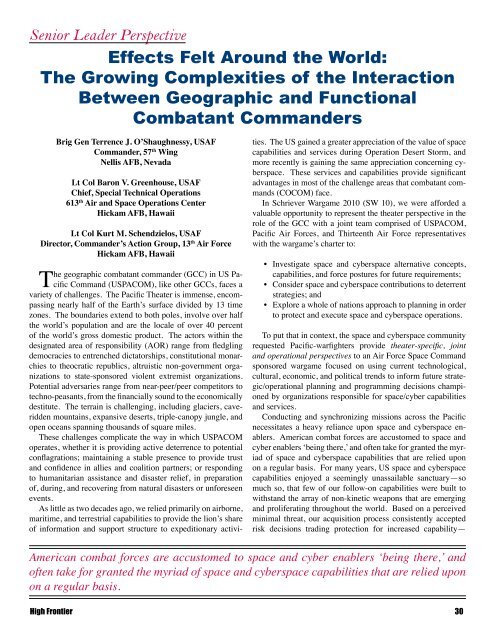Schriever Wargame 2010 - Air Force Space Command
Schriever Wargame 2010 - Air Force Space Command
Schriever Wargame 2010 - Air Force Space Command
You also want an ePaper? Increase the reach of your titles
YUMPU automatically turns print PDFs into web optimized ePapers that Google loves.
Senior Leader Perspective<br />
Effects Felt Around the World:<br />
The Growing Complexities of the Interaction<br />
Between Geographic and Functional<br />
Combatant <strong>Command</strong>ers<br />
Brig Gen Terrence J. O’Shaughnessy, USAF<br />
<strong>Command</strong>er, 57 th Wing<br />
Nellis AFB, Nevada<br />
Lt Col Baron V. Greenhouse, USAF<br />
Chief, Special Technical Operations<br />
613 th <strong>Air</strong> and <strong>Space</strong> Operations Center<br />
Hickam AFB, Hawaii<br />
Lt Col Kurt M. Schendzielos, USAF<br />
Director, <strong>Command</strong>er’s Action Group, 13 th <strong>Air</strong> <strong>Force</strong><br />
Hickam AFB, Hawaii<br />
The geographic combatant commander (GCC) in US Pacific<br />
<strong>Command</strong> (USPACOM), like other GCCs, faces a<br />
variety of challenges. The Pacific Theater is immense, encompassing<br />
nearly half of the Earth’s surface divided by 13 time<br />
zones. The boundaries extend to both poles, involve over half<br />
the world’s population and are the locale of over 40 percent<br />
of the world’s gross domestic product. The actors within the<br />
designated area of responsibility (AOR) range from fledgling<br />
democracies to entrenched dictatorships, constitutional monarchies<br />
to theocratic republics, altruistic non-government organizations<br />
to state-sponsored violent extremist organizations.<br />
Potential adversaries range from near-peer/peer competitors to<br />
techno-peasants, from the financially sound to the economically<br />
destitute. The terrain is challenging, including glaciers, caveridden<br />
mountains, expansive deserts, triple-canopy jungle, and<br />
open oceans spanning thousands of square miles.<br />
These challenges complicate the way in which USPACOM<br />
operates, whether it is providing active deterrence to potential<br />
conflagrations; maintaining a stable presence to provide trust<br />
and confidence in allies and coalition partners; or responding<br />
to humanitarian assistance and disaster relief, in preparation<br />
of, during, and recovering from natural disasters or unforeseen<br />
events.<br />
As little as two decades ago, we relied primarily on airborne,<br />
maritime, and terrestrial capabilities to provide the lion’s share<br />
of information and support structure to expeditionary activities.<br />
The US gained a greater appreciation of the value of space<br />
capabilities and services during Operation Desert Storm, and<br />
more recently is gaining the same appreciation concerning cyberspace.<br />
These services and capabilities provide significant<br />
advantages in most of the challenge areas that combatant commands<br />
(COCOM) face.<br />
In <strong>Schriever</strong> <strong>Wargame</strong> <strong>2010</strong> (SW 10), we were afforded a<br />
valuable opportunity to represent the theater perspective in the<br />
role of the GCC with a joint team comprised of USPACOM,<br />
Pacific <strong>Air</strong> <strong>Force</strong>s, and Thirteenth <strong>Air</strong> <strong>Force</strong> representatives<br />
with the wargame’s charter to:<br />
• Investigate space and cyberspace alternative concepts,<br />
capabilities, and force postures for future requirements;<br />
• Consider space and cyberspace contributions to deterrent<br />
strategies; and<br />
• Explore a whole of nations approach to planning in order<br />
to protect and execute space and cyberspace operations.<br />
To put that in context, the space and cyberspace community<br />
requested Pacific-warfighters provide theater-specific, joint<br />
and operational perspectives to an <strong>Air</strong> <strong>Force</strong> <strong>Space</strong> <strong>Command</strong><br />
sponsored wargame focused on using current technological,<br />
cultural, economic, and political trends to inform future strategic/operational<br />
planning and programming decisions championed<br />
by organizations responsible for space/cyber capabilities<br />
and services.<br />
Conducting and synchronizing missions across the Pacific<br />
necessitates a heavy reliance upon space and cyberspace enablers.<br />
American combat forces are accustomed to space and<br />
cyber enablers ‘being there,’ and often take for granted the myriad<br />
of space and cyberspace capabilities that are relied upon<br />
on a regular basis. For many years, US space and cyberspace<br />
capabilities enjoyed a seemingly unassailable sanctuary—so<br />
much so, that few of our follow-on capabilities were built to<br />
withstand the array of non-kinetic weapons that are emerging<br />
and proliferating throughout the world. Based on a perceived<br />
minimal threat, our acquisition process consistently accepted<br />
risk decisions trading protection for increased capability—<br />
American combat forces are accustomed to space and cyber enablers ‘being there,’ and<br />
often take for granted the myriad of space and cyberspace capabilities that are relied upon<br />
on a regular basis.<br />
High Frontier 30

















